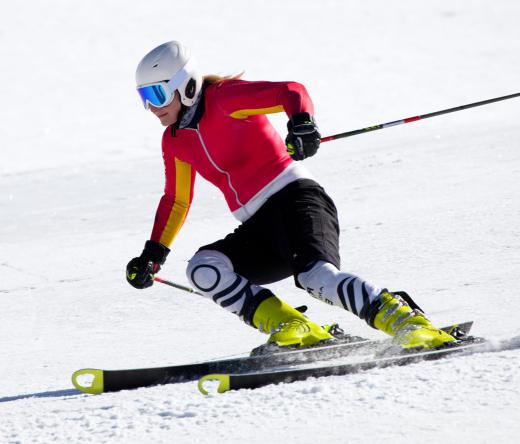The word slalom is derived from the Norwegian word slalam referring to a specific trail in Telemark, Norway, that younger, less practiced skiers used to enhance their skills. Today the winter alpine skiing sport of slalom requires great precision and skill, as well as speed, in order to navigate through an obstacle of gates (normally two round poles, while still attempting to get downhill with the quickest finish time. The original slalom sport, first practiced in the 1930s and increasingly popular with the advent of mechanized ski lifts, has bred two other alpine events, Giant Slalom and Super G. All three sports are featured in alpine ski competitions throughout the world.
The basic test of the slalom is to be able to ski quickly, without missing the sharp turns around gates. For the standard slalom race, male skiers generally face about 55-75 gates, and female skiers must navigate around 40-60 gates. The gates are placed at a distance of about 30 feet (9.14m) apart, and require the skier to perform numerous deft turns in order to stay on course to be able to reach and go around the next gate appropriately. If you miss a gate, you are immediately disqualified, and with the newer inflexible poles, a procedure called blocking the gates no longer works, so the skier’s body must turn precisely in order to successfully ski around a gate.

Scores for slalom are a combination of two runs; disqualification from a single run usually means the competition is over for the skier. In a complex formula, skiers receive points based on time to complete the course, and on style. In most cases, the fastest skier still wins, but in some instances, when the time margin between two skiers is tiny, a skier with a slightly slower time might win based on style. In most international amateur or professional competitions, skiers may not practice on the course.

Giant slalom is a longer course, with further distance between the poles, and greater emphasis on speed. The same rules for disqualification still hold—missing a pole means you're out. The combined sport of Super G has fewer gates, and the race takes place on a downhill course, so speed is much quicker, and accuracy very challenging.
One of the interesting trends in slalom is the different lengths of skis that have been constructed over the years to address the needs of quick and precise skiing with easy course correction. Shorter skis, measuring about 63 inches (160.02 cm) became the preference of athletes in the early 2000s. However, shorter skis greatly reduce stability of the skiers, and can pose a danger. This forced the International Ski Federation (FIS) to mandate specific lengths of skis for the slalom. Currently, no male skier may use a ski shorter than 65 inches (165.1 cm), and no female can use a ski shorter than 61 inches (155 cm) to participate in slalom competitions at the international level.
